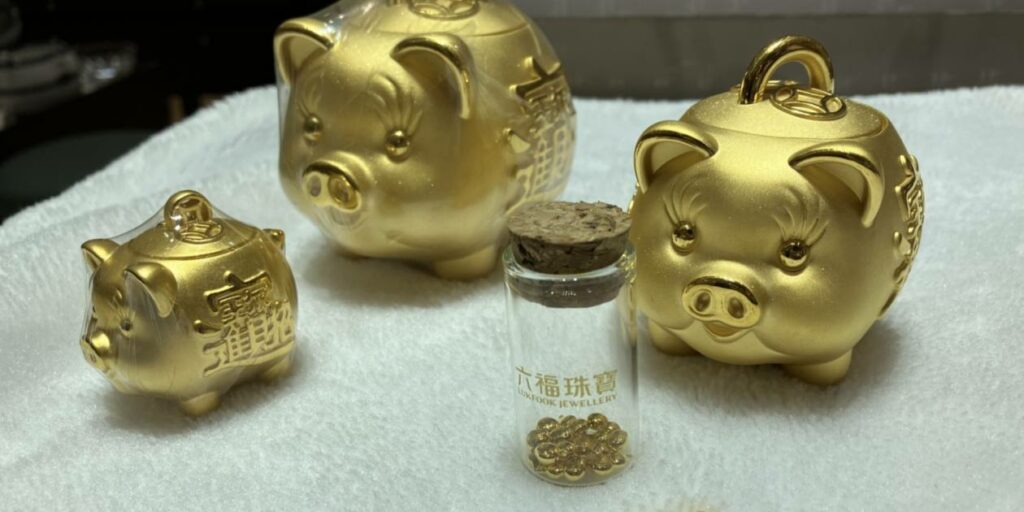SHENZHEN — Gold has not lost its shine for Chinese consumers even amid the economic gloom, with people in their 20s and 30s finding new ways to enjoy the precious metal.
Jinzhan Jewelry Plaza, a market in Shenzhen with nearly 500 shops, bustled with shoppers and onlookers on a recent day. A store owner in his 30s was doing a TikTok livestream to 23,000 viewers as he wove through the crowd, drawing questions from his online audience about prices.
An office worker in her 30s visiting the market bought a gold bracelet for more than 10,000 yuan ($1,400).
“The price of gold continues to rise, so I’m not worried about its value decreasing,” the woman said.
A love for gold has long been part of Chinese culture. Gold is popular both as a gift and as an investment asset, usually among older Chinese.
But a recent fad for so-called golden beans is all about young people. The beans are 1 gram of pure gold, often saved up in a jar little by little. This suggests a desire for a tangible representation of wealth at a time of economic uncertainty.
“Gold is still being bought because it’s easy to see changes in its value, and it gives a different feeling of excitement than just saving money,” one salesperson said.
Lukfook, one of China’s biggest jewelry store chains, sells gold beans shaped like coffee beans, fish and xiaolongbao steamed buns online, as well as solid gold piggy banks in which to store them.
For jewelry stores, gold purchases by young people have become a big source of income. In a survey by industry leader Chow Tai Fook, about 70% of 18- to 40-year-olds expressed interest in buying gold jewelry. Indeed, sales of one of the company’s signature gold products grew 20% in the 2024 fiscal from the year before, with nearly half those purchases coming from people younger than 35.
Chinese consumers bought 294.6 tonnes of jewelry, bullion, coins and other forms of gold in the January-March period, up 13% on the year, the World Gold Council (WGC) reports. China accounts for 37% of global consumer demand for the precious metal.
Though the rise in gold prices has played a major role in driving these purchases, the trend differs a bit from traditional profit-making or investment.
The Chow Tai Fook survey found 64% of Gen Z consumers bought gold jewelry as a treat for themselves or for everyday use. They buy gold because they want it, and the products they buy tend to be affordable.
At one shop in Jinzhan Jewelry Plaza, the most popular items are 1-gram gold cards engraved with phrases like “happy birthday.” There are also thin sheets with pictures of famous characters, each a few centimeters on a side. The store said buyers put them under their transparent smartphone covers.
Half of the store’s customers come from outside Shenzhen.
“We exchange contact information with customers on WeChat, and when new products come out, we contact them and sell online,” a staff member said.
Designs are evolving every day to attract young consumers with fickle tastes.
“Even the high-end gold accessory I bought two years ago feels really old,” said a woman in her 20s visiting the market. “I’ll trade it in and buy something of the same or higher value,” she added as she began hunting for her next purchase.
Young people’s tastes have also begun to influence traditional gold jewelry.
“We are seeing an increase in lightweight, well-designed items and easy-to-buy items for entry-level buyers,” said a WGC China representative.
Chow Tai Fook’s recent bestsellers combine gold and diamonds.
“If the purity is less than 24 carats, the cash value tends to decrease,” the company said. “We have expanded our range by making designs for young people while also focusing on investment products.”
The power of Chinese buying can be felt in international markets for the precious metal. The gold spot price on the Shanghai Gold Exchange has been higher than the international benchmark in London for over a year.
But not all young people are getting in on the boom.
China’s unemployment rate for 16- to 24-year-olds in June was 13.2%, nearly triple the overall 5% rate, the National Bureau of Statistics reports. Only a small percentage of young people get the high-paying jobs that let them join the gold rush.
A Shanghai office worker in his 20s visited a store seeking gold jewelry for his bride to be, but gave up, saying “it’s extremely expensive right now. I can’t buy it until the price comes down a bit.”








